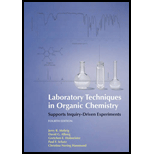
Interpretation:
The reason for the use of a steam bath as the heat source for the distillation of diethyl ether rather than heating mantle should be determined.
Concept introduction:
Distillation is a liquid-gas separation technique for two or more liquids on the basis of their difference in boiling temperature or vapor pressure.Vapor pressure is pressure exerted by vapor phase of liquid produced due to an increase in the molecular kinetic energy of the liquid phase or due to the increase in temperature.
The temperature at which atmospheric pressure exerted on liquid equals to its vapor pressure is known to be its boiling point. Vapor pressure of the component decide boiling point of any mixture. Impurities in the mixture might result in an increase or decrease of observed boiling temperature.
The steps for distillation are as follows:
- In distillation, a round bottom flask is filled one-third or half full with the liquid compound to be distilled. If the flask is overfilled it might flow inside condenser attached to it.
- Then a distilling head is inserted into the round bottom flask and then a condenser is attached to the side joint of the distilling head from where the compound is collected in another smaller round bottom flask after distillation.
- A heat source is placed below the distillation flask.
- A thermometer is carefully inserted in the thermometer adaptor and is placed properly on the distillation head for measuring the boiling temperature of the compound being distilled.
Trending nowThis is a popular solution!

Chapter 12 Solutions
Laboratory Techniques in Organic Chemistry
- What gas law is applicable to the fractional distillation of ethanol-water mixture?arrow_forwardResearch on the process of desalination with the use of distillation. Write how vapor-pressure lowering is utilized and draw a simple illustration on how the process undergoes.arrow_forwardSupposed you are in a chemistry laboratory gave you a 500 ml Erlenmeyer flask containing 200 ml of heterogenous liquid mixture. This liquid mixture consists of sodium chloride, water, benzoic acid, is made by combining Mixture A and Mixture B. Mixture A (aqueous mixture): sodium chloride is dissolved in distilled water. Mixture B (organic mixture): benzoic acid, phenol and aniline is dissolved in petroleum ether (a nonpolar solvent). Your task is to separate the components of the heterogenous mixture and identify the components. What wet chemical analysis/qualitative test should be performed to detect the compounds?arrow_forward
- 2. Calculate the enthalpy of hydration of CuSO, if 16.34 g of CUSO, dissolves in water and gives out 55.51 kJ of heat (Q) and 25.17 g of CuSO4 • SH;O dissolves in water and absorbs 95.31 kJ of heat (Q). The molecular weight for CusO, is 160.00 g/mol, CusO, • SH;0 is 250.00 g/mol. Show ALL calculations-no calculations, no credit! CusO, (s) excess H,O Cu" (aq) so- (aq) AH1 + SH;0 АНа АНа excess H;0 CusO4 • SH20 (s)arrow_forwardIs it possible to freeze ammonia? What conditions would be necessary for frozen ammonia?arrow_forwardAcrylonitrile and ethyl acetate have the same boiling point: 77.20C. Which statement explains the outcome you would expect if a mixture of these two substances were distilled? * The acrylonitrile would vaporize first and the ethyl acetate would be left behinc O The ethyl acetate would vaporize first and the acrylonitrile would be left behind Both substances would vaporize at the same time so distillation would not be h Ethyl acetate is a solid so distillation would involve allowing the acrylonitrile to evaporate. Which statement best explains why structural formulas are good for depicting polymers?arrow_forward
- Suppose 1 g of lauric acid is added to 5 g of stearic acid. Predict the temperature at which this mixture will begin to melt, and justify your answer.arrow_forward3. Think aboutthe definition of boiling point when answering this question.A certain liquid boils at 250oC at room pressure, 1 atmosphere = 760 torr. If we set up the distillation apparatus to distill this liquid, and attach a vacuum pump so the pressure in the apparatus is 10 torr, will the liquid boil at 250oC, at a lower temperature, or at a higher temperature?Explain.arrow_forwardExplain the importance of using a thermometer in the simple distillation setup. Enumerate the characteristics of a substance for it to be separated from the heterogeneous mixture by steam distillation. How does steam facilitate the distillation of essential oils? Discuss some applications of simple distillation and steam distillation. Explain why you can use each method for the chosen application. What is the most dominant intermolecular forces of attraction that exist between: a. water and limonene, the major monoterpene component of lemon essential oil? b. water and constituent ions of sodium chloride? 6. Based on your answers in number 5, which pair (water-limonene or water-sodium chloride) exhibits a stronger attraction between their molecules/ions? 7. Describe what happens during the salting-out process in terms of the intermolecular forces of attraction involved as mentioned in your previous answers.arrow_forward
- The followings methods are useful to induce crystallization EXCEPT adding a small crystal of the desired compound, called a seed crystal, to the solution adding anhydrous potassium carbonate to the solution and cooling it in an ice bath scratching the inner wall of the Erlenmeyer flask with a glass stirring rod reheating the solution to boiling to boil off some of the solvent, and then allow the solution to cool to room temperature again to effect crystallizationarrow_forwardwhy oils leave a translucent spot on paper even after drying while ethanol and water do notarrow_forwardWhy is fractional distillation more efficient than simple distillation when purifying liquid mixtures?arrow_forward
 Macroscale and Microscale Organic ExperimentsChemistryISBN:9781305577190Author:Kenneth L. Williamson, Katherine M. MastersPublisher:Brooks Cole
Macroscale and Microscale Organic ExperimentsChemistryISBN:9781305577190Author:Kenneth L. Williamson, Katherine M. MastersPublisher:Brooks Cole Chemistry for Today: General, Organic, and Bioche...ChemistryISBN:9781305960060Author:Spencer L. Seager, Michael R. Slabaugh, Maren S. HansenPublisher:Cengage Learning
Chemistry for Today: General, Organic, and Bioche...ChemistryISBN:9781305960060Author:Spencer L. Seager, Michael R. Slabaugh, Maren S. HansenPublisher:Cengage Learning


